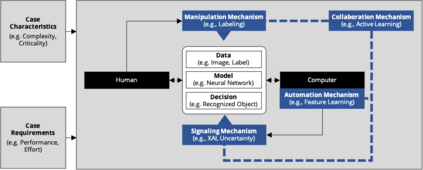Computer vision (CV) techniques try to mimic human capabilities of visual perception to support labor-intensive and time-consuming tasks like the recognition and localization of critical objects. Nowadays, CV increasingly relies on artificial intelligence (AI) to automatically extract useful information from images that can be utilized for decision support and business process automation. However, the focus of extant research is often exclusively on technical aspects when designing AI-based CV systems while neglecting socio-technical facets, such as trust, control, and autonomy. For this purpose, we consider the design of such systems from a hybrid intelligence (HI) perspective and aim to derive prescriptive design knowledge for CV-based HI systems. We apply a reflective, practice-inspired design science approach and accumulate design knowledge from six comprehensive CV projects. As a result, we identify four design-related mechanisms (i.e., automation, signaling, modification, and collaboration) that inform our derived meta-requirements and design principles. This can serve as a basis for further socio-technical research on CV-based HI systems.
翻译:计算机愿景(CV)技术试图模仿人的视觉认知能力,以支持劳动密集型和耗时的工作,如关键物体的识别和定位。如今,CV越来越多地依靠人工智能(AI)从可用于决策支持和业务流程自动化的图像中自动提取有用信息,然而,在设计基于AI的CV系统时,现有研究的重点往往完全集中在技术方面,而忽视了信任、控制和自主等社会技术方面。为此目的,我们从混合情报的角度考虑设计这类系统,目的是为基于CV的HI系统提供规范设计知识。我们采用了反思、实践引导的设计科学方法,积累了六个全面的CVHI项目的设计知识。结果,我们确定了四种与设计有关的机制(即自动化、信号、修改和合作),为我们衍生的元要求和设计原则等内容提供信息。这可以作为基于基于CVH的系统进行进一步社会技术研究的基础。














